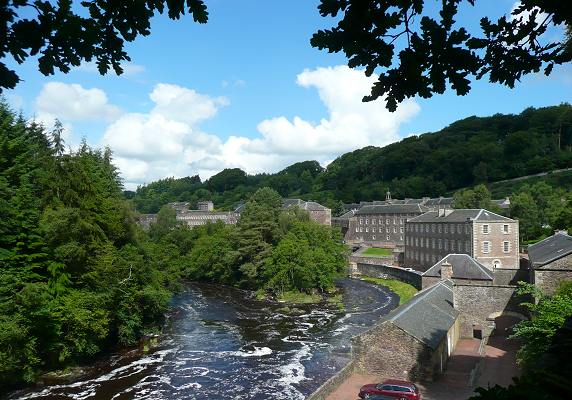A historical centre for renewable energy production
New Lanark was founded by Scottish entrepreneur David Dale in 1785. It developed as a model industrial community under the enlightened management of Robert Owen. The revolution in New Lanark was not just industrial. It delivered pioneering social and educational change, aimed at creating a better and fairer society.
The cotton mills in New Lanark were built in the late 18th century by David Dale to take advantage of the water power available from the Clyde. A weir built above Dundaff Linn, the smallest of the Falls of Clyde, retained water to divert it through a tunnel to a lade built at the back of the mills. Each of the four mills had its own waterwheel (or waterwheels) built underneath to take water from the lade and discharge it into a tail-race, which fed the water back into the Clyde. The waterwheel drove a vertical driveshaft through bevel gears. At each floor, a horizontal drive shaft took power from the main shaft through bevel gears. Waterwheels were troublesome and from 1886 onwards, there began a series of developments with turbines which eventually replaced all the waterwheels. In 1898, a dynamo was attached to one of the turbines to produce electricity for lighting the mills and the village houses. The power output was feeble and, as electrical appliances such as radios and irons became available, the demand for power could not be met and led to frequent blowing of fuses.
In 1955, the decision was made to link the village housing to the public mains supply. At about the same time, individual electric motors were fitted to the mill machines and were powered by the output from induction generators coupled to the turbines.
In the restoration of the mills, the New Lanark Trust used the remaining water turbine to generate electrical power. This, a Swedish-built Boving turbine installed in Mill Three in 1931, was coupled to a modern induction generator to produce up to 380kw of electricity per hour to supply most of the needs of the New Lanark Mill Hotel and Visitor Centre. Any surplus is exported back into the grid. The power also drives the 19th century spinning mule, not only for demonstration to visitors, but also for the commercial production of high quality woollen yarn, mainly for home knitting.
The Trust has extended its use of sustainable energy by using two heat pump systems to extract heat from the water. One uses heat-exchange plates fixed to the wall of the lade to heat the Institute and the other takes heat from the wheel-race under Mill Two to heat the Hotel swimming pool and leisure suite.
Sources:
















